-

新人教版高中英语必修3Unit 2 Morals and virtues教学设计一
(2) students are divided into groups according to the requirements of activity 3. Each student shares a story of personal experience or hearing-witnessing kindness, and then selects the most touching story in the group and shares it with the whole class. Before the students share the story, the teacher can instruct them to use the words and sentence patterns in the box to express. For example, the words in the box can be classified:Time order: first of all, then, after that, later, finally logical relationship :so, however, although, butTeachers can also appropriately add some transitional language to enrich students' expression:Afterwards, afterwards, at last, in the end, eventuallySpatial order: next to, far from, on the left, in front ofOtherwise, nevertheless, as a result, therefore, furthermore, in addition, as well asSummary: in a word, in short, on the whole, to sum up, in briefStep 8 Homework1. Understand the definition of "moral dilemma" and establish a correct moral view;2. Accumulate vocabulary about attitudes and emotions in listening texts and use them to express your own views;3. Complete relevant exercises in the guide plan.1、通过本节内容学习,学生能否理解理解“道德困境”的定义;2、通过本节内容学习,学生能否通过说话人所表达的内容、说话的语气、语调等来判断其态度和情绪;3、通过本节内容学习,学生能否针对具体的道德困境发表自己的看法和见解,能否掌握听力理训练中的听力策略。

新人教版高中英语必修3Unit 3 Diverse Cultures教学设计二
(2)Consolidate key vocabulary.Ask the students to complete the exercises of activity 6 by themselves. Then ask them to check the answers with their partners.(The first language:Damage of the 1906 San Francisco earthquake and fire.A second language: Yunnan - one of the most diverse provinces in China).Step 5 Language points1. The teacher asks the students to read the text carefully, find out the more words and long and difficult sentences in the text and draw lines, understand the use of vocabulary, and analyze the structure of long and difficult sentences.2. The teacher explains and summarizes the usage of core vocabulary and asks the students to take notes.3. The teacher analyzes and explains the long and difficult sentences that the students don't understand, so that the students can understand them better.Step 6 Homework1. Read the text again, in-depth understanding of the text;2. Master the use of core vocabulary and understand the long and difficult sentences.3. Complete relevant exercises in the guide plan.1、通过本节内容学习,学生是否理解和掌握阅读文本中的新词汇的意义与用法;2、通过本节内容学习,学生能否结合文本特点了解文章的结构和作者的写作逻辑;3、通过本节内容学习,学生能否了解旧金山的城市风貌、文化特色,以及加利福尼亚州的历史,体会多元文化对美国的影响。
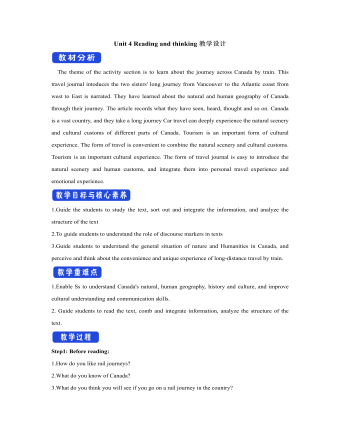
新人教版高中英语选修2Unit 4 Reading and thinking教学设计
【词汇精讲】highlight n.最好或最精彩的部分 vt.突出;强调;使醒目One of the highlights of the trip was seeing the Taj Mahal.这次旅行的亮点之一是参观泰姬陵。Your resume should highlight your skills and achievements.你的简历应该突出你的技能和成就。The report highlights the major problems facing society today.报告强调了当今社会所面临的主要问题。I’ve highlighted the important passages in yellow.我用黄色标出了重要段落。7.Edmonton is freezing cold in winter,with daily temperatures averaging -10 ℃.埃德蒙顿冬季寒冷,日平均气温为-10°C。【词汇精讲】freezing adj.极冷的;冰冻的Leave a basin of water outside in freezing weather.在冰冻的天气里,放一盆水在室外。It’s freezing cold outside so wear a warm coat.外面超冷的,所以穿一个暖和一点的外套吧。8.It was not until 9:30 a.m.that they finally reached the capital of Ontario,Toronto.直到上午9时30分,他们才终于到达多伦多的首府安大略省。【句式剖析】本句是一个强调句,强调的是句子的时间状语until 9:30。含有not...until...的句子的强调句为It is not until...that...,that后面的句子要用肯定形式。It was not until then that I suddenly realized nobody was happier than I was.直到那时我才突然意识到没有人比我更幸福了。
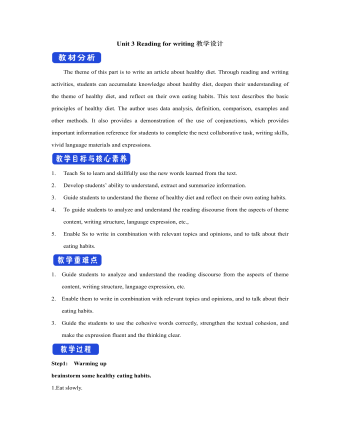
新人教版高中英语选修2Unit 3 Reading for writing教学设计
The theme of this part is to write an article about healthy diet. Through reading and writing activities, students can accumulate knowledge about healthy diet, deepen their understanding of the theme of healthy diet, and reflect on their own eating habits. This text describes the basic principles of healthy diet. The author uses data analysis, definition, comparison, examples and other methods. It also provides a demonstration of the use of conjunctions, which provides important information reference for students to complete the next collaborative task, writing skills, vivid language materials and expressions.1. Teach Ss to learn and skillfully use the new words learned from the text.2. Develop students’ ability to understand, extract and summarize information.3. Guide students to understand the theme of healthy diet and reflect on their own eating habits.4. To guide students to analyze and understand the reading discourse from the aspects of theme content, writing structure, language expression, etc., 5. Enable Ss to write in combination with relevant topics and opinions, and to talk about their eating habits.1. Guide students to analyze and understand the reading discourse from the aspects of theme content, writing structure, language expression, etc.2. Enable them to write in combination with relevant topics and opinions, and to talk about their eating habits.3. Guide the students to use the cohesive words correctly, strengthen the textual cohesion, and make the expression fluent and the thinking clear.Step1: Warming upbrainstorm some healthy eating habits.1.Eat slowly.2.Don’t eat too much fat or sugar.3.Eat healthy food.4.Have a balanced diet.Step2: Read the passage and then sum up the main idea of each paragraph.
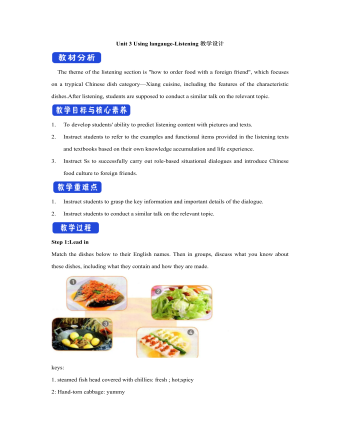
新人教版高中英语选修2Unit 3 Using langauge-Listening教学设计
1. How is Hunan cuisine somewhat different from Sichuan cuisine?The heat in Sichuan cuisine comes from chilies and Sichuan peppercorns. Human cuisine is often hotter and the heat comes from just chilies.2.What are the reasons why Hunan people like spicy food?Because they are a bold people. But many Chinese people think that hot food helps them overcome the effects of rainy or wet weather.3.Why do so many people love steamed fish head covered with chilies?People love it because the meat is quite tender and there are very few small bones.4.Why does Tingting recommend bridge tofu instead of dry pot duck with golden buns?Because bridge tofu has a lighter taste.5 .Why is red braised pork the most famous dish?Because Chairman Mao was from Hunan, and this was his favorite food.Step 5: Instruct students to make a short presentation to the class about your choice. Use the example and useful phrases below to help them.? In groups of three, discuss what types of restaurant you would like to take a foreign visitor to, and why. Then take turns role-playing taking your foreign guest to the restaurant you have chosen. One of you should act as the foreign guest, one as the Chinese host, and one as the waiter or waitress. You may start like this:? EXAMPLE? A: I really love spicy food, so what dish would you recommend?? B: I suggest Mapo tofu.? A: Really ? what's that?
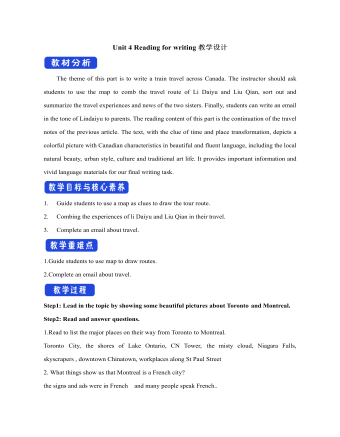
新人教版高中英语选修2Unit 4 Reading for writing教学设计
假定你是英国的Jack,打算来中国旅行,请你给你的中国笔友李华写一封信,要点如下:1.你的旅行计划:北京→泰山→杭州;2.征求建议并询问他是否愿意充当你的导游。注意:1.词数80左右(开头和结尾已给出,不计入总词数);2.可以适当增加细节,以使行文连贯。参考词汇:故宫 the Forbidden City;泰山 Mount TaiDear Li Hua,I'm glad to tell you that 'm going to visit China.First,I am planning to visit Beijing,the capitalof China,where I am looking forward to enjoying the Great Wall,the Forbidden City and somebeautiful parks.Then I intend to go to visit Mount Tai in Shandong Province.I've heard that it is one ofthe most famous mountains in China and I can't wait to enjoy the amazing sunrise there.After that,I amalso going to Hangzhou.It is said that it is a beautiful modern city with breathtaking natural sights,among which the West Lake is a well- known tourist attraction.What do you think of my travel plan? Will you act as my guide? Hope to hear from you soon.

新人教版高中英语选修2Unit 5 Using langauge-Listening教学设计
The theme of this section is to learn how to make emergency calls. Students should learn how to make emergency calls not only in China, but also in foreign countries in English, so that they can be prepared for future situations outside the home.The emergency telephone number is a vital hotline, which should be the most clear, rapid and effective communication with the acute operator.This section helps students to understand the emergency calls in some countries and the precautions for making emergency calls. Through the study of this section, students can accumulate common expressions and sentence patterns in this context. 1.Help students accumulate emergency telephone numbers in different countries and learn more about first aid2.Guide the students to understand the contents and instructions of the telephone, grasp the characteristics of the emergency telephone and the requirements of the emergency telephone.3.Guide students to understand the first aid instructions of the operators.4.Enable Ss to make simulated emergency calls with their partners in the language they have learned1. Instruct students to grasp the key information and important details of the dialogue.2. Instruct students to conduct a similar talk on the relevant topic.Step1:Look and discuss:Match the pictures below to the medical emergencies, and then discuss the questions in groups.
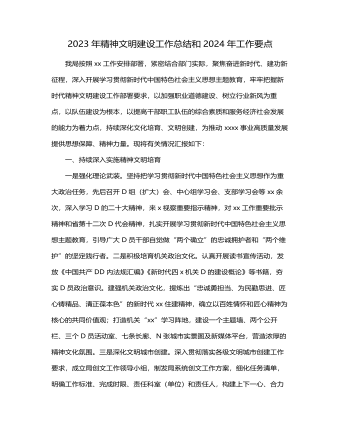
2023年精神文明建设工作总结和2024年工作要点
围绕全市经济社会发展,聚焦房地产业平稳健康发展,坚持“房住不炒”定位,稳地价、稳房价,完成全市商品房销售面积xxx.xx万平方米;聚焦建筑产业增效提质,完成建筑业总产值xxx亿元、同比增长xx%,不断提升住建工作在全市中心大局中的贡献率。以“时时放心不下”的责任感,常态化在系统上下开展安全生产、生态文明等方面宣传教育,干部职工安全意识、环保意识、疫情防控意识强,办公场所、建筑工地等井然有序、优质高效、安全文明,今年无较大安全生产事故发生。三是保持大局稳定。新聘请政风行风监督员xx名,参与重大决策的全过程监督,及时发现并纠正不正之风,切实解决人民群众关注的热点、难点问题。建立重大活动、政策、项目的舆情风险评估机制,指定x名舆情信息员,及时收集、研判、处置可能引发群体性事件和社会动荡的舆情;在重要会期、重大节假日期间系统内无赴省进京越级上访、无因信访问题引发的极端恶性事件和舆论负面炒作事件,保持了社会和谐稳定。
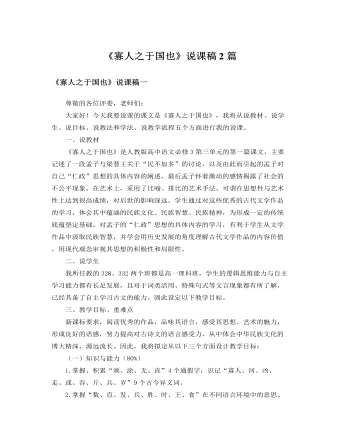
人教版高中语文必修3《寡人之于国也》说课稿2篇
(明确:“寡人之于国也,尽心焉耳矣”,但“寡人之民不加多,何也?”)②他认为自己对国家政务尽心尽力了,他有哪些具体做法?(明确:移民移粟)③第2—4节中孟子是怎样说明梁惠王移民移粟的措施与“邻国之政”并无本质区别的?(明确:孟子不直接回答“民不加多”的问题,而是用梁惠王熟悉的“战”设喻——设圈套,诱使对方在不知不觉中说出“不可,直不百步耳,是亦走也。”)④孟子认为怎样才能做到“王道之始”?要想“王道之成”还需采取哪些措施?(明确:“不违农时,谷不可胜食也。数罟不入氵夸池,鱼鳖不可胜食也。斧斤以时入山林,材木不可胜用也。谷与鱼鳖不可胜食,材木不可胜用五亩之宅,树之以桑,五十者可以衣帛矣。鸡豚狗彘之畜,无失其时,七十者可以食肉矣。百亩之田,勿夺其时,数口之家,可以无饥矣。谨库序之教,申之以孝涕之义,颁白者不负戴于道路矣。)这一小步的目的是想让学生通过这些问题的解答,可以进一步理清思路,掌握文的大概内容。
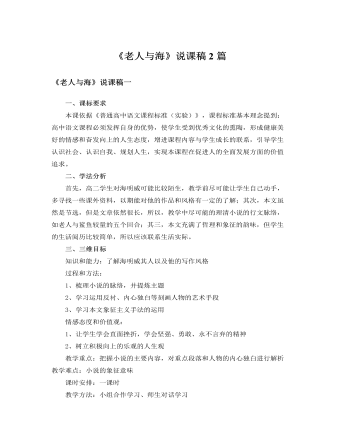
人教版高中语文必修3《老人与海》说课稿2篇
3、重要语句的理解“可是一个人并不是生来要给打败的,你尽可把它消灭掉,可就是打不败他。”解析:这是老人第一次回合之后的内心独白,也是此小说的核心精神,充分体现了老人桑地亚哥的生命理念。整句话可以分为两部分来理解,前句告诉我们,人生活在自然与社会当中,必不可少要面临一些坎坷、磨难,这些磨难、坎坷完全可以造成躯体的消灭、消亡,这是人生命的脆弱性。后句,面对挫折,只要保持一种乐观的精神,拥有一颗坚强的心灵,那么,人类执着奋斗的精神将永不磨灭。4、象征主义题目是《老人与海》,而表明上,小说是写一位老人及其在海上的经历,但实际上,老人的形象极具概括性,他已经超越了一个人的存在,而成为了人生的一种象征。老人桑地亚哥就是“硬汉子”的代表,大海则是生命旅途的象征,鲨鱼则是我们行走中的“强物”,厄运的象征。人的一生不可能一帆风顺,不经历风雨,怎能见彩虹,走在人生路途中,不可避免我们都要遇到挫折,被厄运所阻挠,只有经历与“鲨鱼”的较量,才能成为强者,唱出最美的歌。
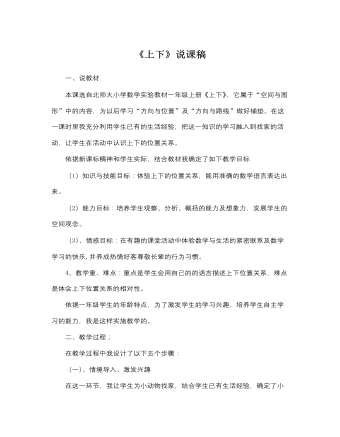
北师大版小学数学一年级上册《上下》说课稿
一、说教材本课选自北师大小学数学实验教材一年级上册《上下》,它属于“空间与图形”中的内容,为以后学习“方向与位置”及“方向与路线”做好铺垫。在这一课时里我充分利用学生已有的生活经验,把这一知识的学习融入到找家的活动,让学生在活动中认识上下的位置关系。依据新课标精神和学生实际,结合教材我确定了如下教学目标(1)知识与技能目标:体验上下的位置关系,能用准确的数学语言表达出来。(2)能力目标:培养学生观察、分析、概括的能力及想象力,发展学生的空间观念。(3)、情感目标:在有趣的课堂活动中体验数学与生活的紧密联系及数学学习的快乐,并养成热情好客尊敬长辈的行为习惯。4、教学重、难点:重点是学生会用自己的的语言描述上下位置关系,难点是体会上下位置关系的相对性。依据一年级学生的年龄特点,为了激发学生的学习兴趣,培养学生自主学习的能力,我是这样实施教学的。
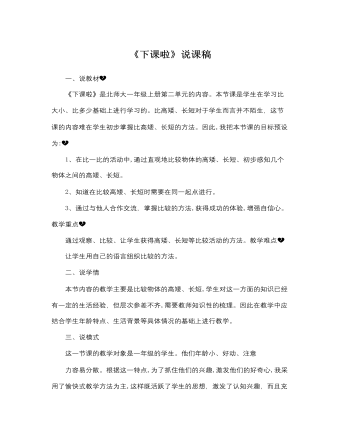
北师大版小学数学一年级上册《下课啦》说课稿
一、说教材《下课啦》是北师大一年级上册第二单元的内容。本节课是学生在学习比大小、比多少基础上进行学习的。比高矮、长短对于学生而言并不陌生,这节课的内容难在学生初步掌握比高矮、长短的方法。因此,我把本节课的目标预设为:1、在比一比的活动中,通过直观地比较物体的高矮、长短、初步感知几个物体之间的高矮、长短。2、知道在比较高矮、长短时需要在同一起点进行。3、通过与他人合作交流,掌握比较的方法,获得成功的体验,增强自信心。教学重点通过观察、比较、让学生获得高矮、长短等比较活动的方法。教学难点让学生用自己的语言组织比较的方法。二、说学情本节内容的教学主要是比较物体的高矮、长短,学生对这一方面的知识已经有一定的生活经验,但层次参差不齐,需要教师知识性的梳理。因此在教学中应结合学生年龄特点、生活背景等具体情况的基础上进行教学。
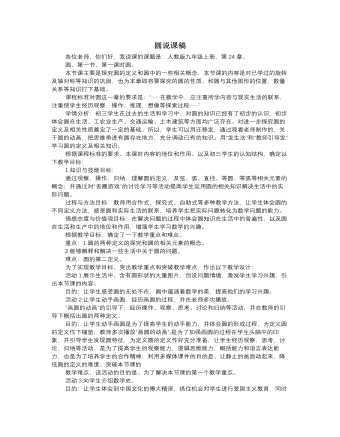
北师大版初中数学九年级下册圆说课稿
活动6:通过随堂小测的方式辨别圆的相关概念。目的:让学生准确地掌握直径与弦,弧与半圆的关系,以及准确理解等圆和等弧的概念。活动7:让学生分组讨论“投圈游戏”,解决生活中的实际问题。目的:提高学生运用所学圆的知识,解决实际问题的能力;也是为了巩固圆的定义,同时再次激发学生的学习兴趣。活动8:给学生一个草坪情境,要求作出半径为5m的圆,并说明原理。目的:提高学生的综合运用能力,并巩固圆的定义。活动9:让学生根据树木的年轮的直径和生长年龄,计算树木每年的生长情况。目的:巩固圆的知识。活动10:让学生回顾本节课的重要内容并布置课后作业。目的:前者的目的是梳理圆及圆的相关元素的概念,便于识记、理解和运用。后者的目的是:第一题,检测学生的动手能力和提高学生学习数学的兴趣;第二题,检测学生对本节课的重要内容的理解情况;第三题,检测学生的综合运用能力。以上是我对本节课内容的理解和设计。

人音版小学音乐一年级上法国号口风琴教学说课稿
6、学生展示此环节教学时我借助演唱和口风琴伴奏、口风琴与舞蹈律动、口风琴与打击乐合奏等形式,给时间学生自由组合,让同学们分组合作展示。力求同学之间互帮互助、相互启发,以此增进学生的团队合作精神。7、课堂小结小结时我鼓励学生开展互评、自评等方式,从而让学生正视自己,尊重他人。七、课后反思“兴趣是最好的老师”,此节音乐课的设计我觉得充满了乐趣,教学时处处呈现师生合作,生生合作的愉快场景。“大风与小风”的游戏成了本节课的亮点,它让学生在自主参与音乐实践中体会到音乐的无限魅力。但不足的是实际操作过程中由于时间的关系曲子弹得不够扎实,个别学生弹得不够熟练。以上设计如有不足之处,敬请各位专家、同仁提出宝贵意见。谢谢!
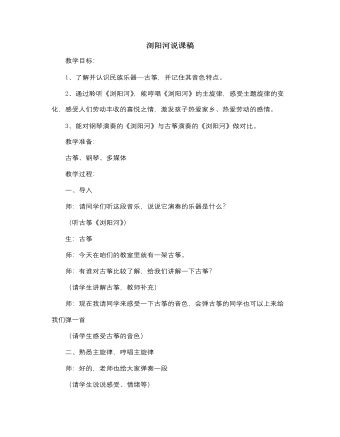
人音版小学音乐三年级上册浏阳河说课稿
三、拓展师:浏阳河十曲九弯,碧波荡漾,你听,在浏阳河畔传来了阵阵歌声(听歌曲《浏阳河》)师:你觉得歌曲《浏阳河》与古筝曲《浏阳河》有什么异同?(请学生各抒己见,说说歌曲与乐曲的异同)师:的确,无论是歌曲还是乐曲都非常的优美动听,都表达了对浏阳河的赞美、热爱之情。四、延伸师:今天我们学了民族乐器—古筝,你知道的民族乐器还有哪些?生:二胡、葫芦丝、琵琶、扬琴、笛子、萧师:李老师这里有几段音乐,请你来辨别一下,哪一段音乐是用古筝演奏的?(辨别古筝的音色)师:今天通过《浏阳河》,咱们认识了古筝,并熟悉了古筝的音色。在以后,我们还将一一的学习另外的民族乐器。五、小结《浏阳河》的旋律六十年前传遍了大江南北,今天的它依旧流行在我们的心中,如今它更是唱响了世界,希望大家永远记住浏阳河的声音,让这旋律伴你成长。

人音版小学音乐三年级上册美丽的黄昏说课稿
(四)轮唱歌曲,表现黄昏。本环节设计了一个三部轮唱,主要源于三年级上册已经出现了轮唱,二部轮唱对于他们来说基本可以,如果加入三部轮唱,歌曲的意境会表现的更加淋漓尽致。(五)竖笛演奏,再现黄昏。在本环节中通过教师吹奏竖笛,学生打击乐伴奏,学生聆听竖笛演奏的《美丽的黄昏》,布置学生课后练习竖笛演奏。感受声乐、器乐表现的相同与不同之处,提高学生的音乐感受力。本节课为了让学生更好地聆听二拍子和三拍子的特点,我们精心选择了教材并自制了歌曲伴奏,通过本节课的学习,学生对四三拍有了很好的内心体验,并自然而然的在歌曲中表现出来。引导学生在参与音乐活动中,学习知识;提高技能;收获成功,体验合唱的美妙!学生在音乐中变得更加热情、开朗,自信。
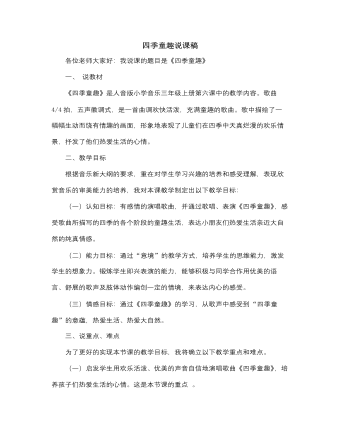
人音版小学音乐三年级上册四季童趣说课稿
同时,鼓励孩子采用其它方式表现歌曲意境。2、在充分地准备之后,各组成果展示。 最后通过学生互评和教师评价,发挥课堂的反馈作用,让学生体验到参与学习的乐趣3、教师小结:小朋友通过各自的方式表达了对四季美好景色的赞美,希望你们在今后的生活中去发现更多的大自然的美,拥抱美好的未来。[新课标指出,音乐教学应重视音乐与相关文化的适当渗透。在这个环节中,我设计了请学生自主发挥,选择多种艺术形式表现歌曲意境的方案,为孩子创造了一个可展现个性的舞台,还使学生感受到丰富多彩的艺术形式,激发学生的兴趣,拓展了学生的思维。六、课堂小结,组织下课 5分钟1、老师对本课内容做一小结:鼓励孩子们会善于发现大自然中的美,也希望孩子们都能成为一个善于表现美的孩子。对孩子进行思想教育。
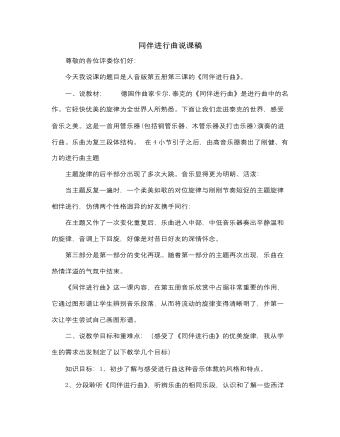
人音版小学音乐三年级上册同伴进行曲说课稿
一、说教材: 德国作曲家卡尔.泰克的《同伴进行曲》是进行曲中的名作。它轻快优美的旋律为全世界人所熟悉。下面让我们走进泰克的世界,感受音乐之美。这是一首用管乐器(包括铜管乐器、木管乐器及打击乐器)演奏的进行曲。乐曲为复三段体结构。 在4小节引子之后,由高音乐器奏出了刚健、有力的进行曲主题主题旋律的后半部分出现了多次大跳。音乐显得更为明朗、活泼:当主题反复一遍时,一个柔美如歌的对位旋律与刚刚节奏短促的主题旋律相伴进行,仿佛两个性格迥异的好友携手同行:在主题又作了一次变化重复后,乐曲进入中部,中低音乐器奏出平静温和的旋律,音调上下回旋,好像是对昔日好友的深情怀念。第三部分是第一部分的变化再现。随着第一部分的主题再次出现,乐曲在热情洋溢的气氛中结束。
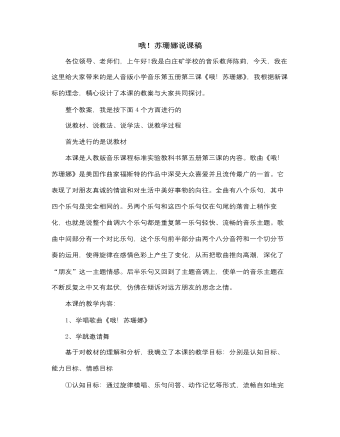
人音版小学音乐三年级上册哦!苏珊娜说课稿
本课是人教版音乐课程标准实验教科书第五册第三课的内容。歌曲《哦!苏珊娜》是美国作曲家福斯特的作品中深受大众喜爱并且流传最广的一首。它表现了对朋友真诚的情谊和对生活中美好事物的向往。全曲有八个乐句,其中四个乐句是完全相同的。另两个乐句和这四个乐句仅在句尾的落音上稍作变化,也就是说整个曲调六个乐句都是重复第一乐句轻快、流畅的音乐主题。歌曲中间部分有一个对比乐句,这个乐句前半部分由两个八分音符和一个切分节奏的运用,使得旋律在感情色彩上产生了变化,从而把歌曲推向高潮,深化了“朋友”这一主题情感。后半乐句又回到了主题音调上,使单一的音乐主题在不断反复之中又有起伏,仿佛在倾诉对远方朋友的思念之情。本课的教学内容:1、学唱歌曲《哦!苏珊娜》2、学跳邀请舞
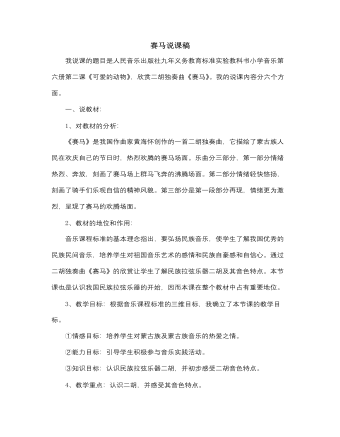
人音版小学音乐三年级上册赛马说课稿
[设计意图]:利用交互式的电脑课件演示,创设教学情境,使学生通过了解蒙古族的风土人情开拓文化视野,从而产生对蒙古族的热爱之情,并培养学生欣赏音乐的兴趣。(三)新课导入有一首曲子淋漓尽致的刻画了蒙古族人民在赛马场上的情景,那就是由我国作曲家黄海怀创作的二胡独奏曲《赛马》。介绍二胡:(教学重点)是我国的民族传统乐器,它是通过琴弓与两根琴弦磨擦产生振动传到鼓面上发出的声音。二胡可以演奏各种情绪的音乐,不但能演奏优美婉转的乐曲,还能表现热烈欢快的旋律。更能模仿一些特殊的声音。二胡演奏法其中的三种:连弓、连顿弓、拨弦。二胡由琴筒、琴皮、琴杆、琴头、琴轴、千斤、琴马、弓子和琴弦等部分组成,另外还有松香等附属物。
